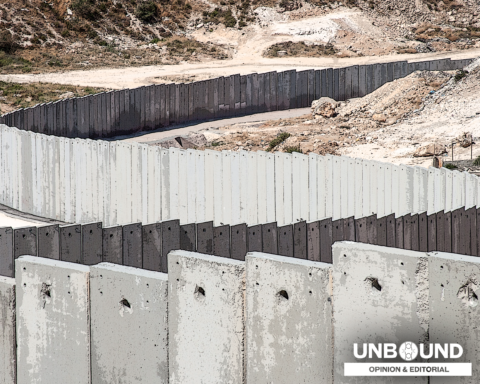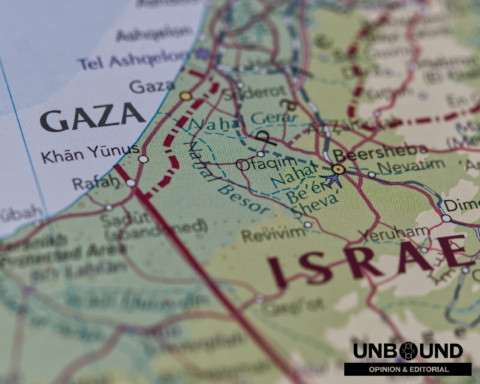Mosaic of Peace 2018, Day 1
May 1, Jerusalem

and Rev. Victor Makari (left to right)
“What does it mean for us to be here, in Jerusalem?”
It’s a question that has as many answers as the diverse peoples who inhabit or visit this many-faceted city.
Our first full day in the Old City of Jerusalem falls on May 1st: May Day, or the Labor Day celebration of most of the world. As a result, in visiting the Church of the Redeemer in Jerusalem we got to meet His Grace, Bishop Sani Ibrahim Azar, in person. He had come to open the doors to the church himself, since most of the staff was on holiday, and greeted us together with Rev. Victor Makari.
For Bishop Azar, the question of place is a complicated one, since he has no Israeli passport to facilitate his travel between Jordan and Israel-Palestine. Instead, he has an Israeli “travel document,” with no claim to Israeli citizenship. Neither does his Jordanian passport list him as a citizen. When questioned at the border, an agent wrote on the passport: “stateless”. And, in order to (successfully) obtain a visa to visit the United States for official visits, Bishop Azar had two options to choose for “country of origin”: West Bank, or Jerusalem.
Neither, of course, is an autonomous country. But although Bishop Azar’s document status is a whirlwind of contradictions, his presence in Jerusalem was absolutely grounded. When asked by PC(USA) co-moderator Denise Anderson, “What message do you need us to take back home?” he replied:
“There are still Christians in the Holy Land, and they will stay because they see it is the place to be. [We are] strong believers in God’s will… and we know there is a wall in our hearts, and we need help to break down the walls in our hearts and in this land.”
To Bishop Azar’s mind, the dwindling Christian population in the area is increasingly moving toward the way of love. He sees hope in their remaining, that perhaps they may help to bridge the gap between increasingly divided Muslims and Jews. As he talked, the familiar tune “Ein Feste Burg (A Mighty Fortress)” played in the background somewhere. We closed our time together singing the three-part canon of “Dona Nobis Pacem”.
We danced around these themes of identity and location throughout the rest of the day as well, and with so many eloquent speakers I’m forced to limit each to little more than a quote:

“Religions bring peace—not the killing that was done in their name”
Nora Kort works to educate people through many projects and founded the Wujoud (Existence) Museum, located in space nestled between the different quarters of Jerusalem. She spoke of barriers to development for Palestinians (the old sign “Arab Orthodox Society” is left hanging out front for institutional security) and of attempted intimidation by Israeli soldiers.

“My commitment to live and stay in this country is because of the misuse of my holy book”
Nora Carmi was a PC(USA) International Peacemaker in 2017, and she spoke of her permanent resident status in East Jerusalem and the ongoing struggle to keep Jerusalem an open city. The “misuse” to which she refers is the abandonment of the prophets’ critical voices (she cites the prophet Amos as an example).

Let’s not look for differences the first time we meet each other”; AND
“I see the suffering of my own people. A [position] balanced between occupier & occupied is an immoral stance”
Dr. Mustafa Abu Sway, before discussing local injustices, spoke first of worldwide suffering and flaws in the “world order”—particularly the imbalance in basic resources which leaves behind the Global South. He also spoke of the “womb relationship” which Muslims offer to neighbors, upon only two conditions: no attack, and no displacement. Though he acknowledged that Judeophobia is real, alongside Islamophobia, he also stated “I AM a Semite” emphasizing that their struggle at its core is not racial.

“The hope is in children”
Dr. Ron Kronish, described a diverse international summer camp in New York that bridged the Israel/Palestine, White/Black, and other conflict divides. Interviewing those children at the end of the camp, one child pointed out that although peace might be hard for politicians, the campers had managed to build a peaceful coexistence.
These many hopes and challenges, embraced by each of these speakers, were humbling in their magnitude. As we wrapped up this jam-packed day, there was a certain exhaustion…and yet a sense that a mosaic of formidable people, inspired by a love that transcends any of these singe forms of monotheism, are working for the cause of justice in this place.
***
The Mosaic of Peace trip is part of the ministry of the Presbyterian Peace Program. It brings members and partners of the PC(USA) from a variety of backgrounds to Israel-Palestine in order to “experience this remarkable and troubled region, encounter its diverse people, explore its rich history and complex current situation, and engage with those who seek its peace.”
This blog entry was contributed by Henry Koenig Stone, as part of our effort to bring back and share the stories of Mosaic of Peace 2018. All five photos were contributed by Diane Fitch. The full blog is co-hosted by Unbound and by the Presbyterian Peacemaking Program.





Unbound Social